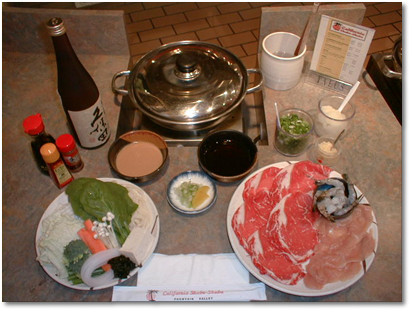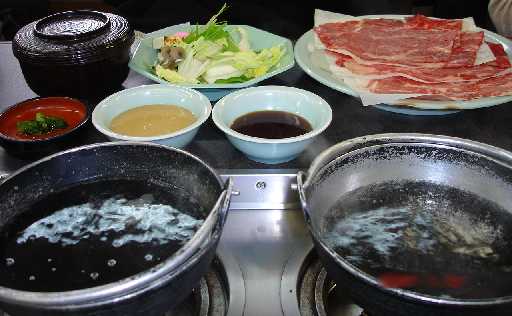Shabu-Shabu

Shabu-shabu, also spelled "syabu-syabu", is a Japanese variant of hot pot. The dish is related to sukiyaki in style, where both use thinly sliced meat and vegetables, and usually served with dipping sauces. However, it is starkly different in taste; shabu-shabu is more savory and less sweet than sukiyaki. It is considered a winter dish but is eaten year-round.
The dish originated in the 13th century as a way for Genghis Khan to efficiently feed his soldiers. Mongol troops gathered around a large pot and cooked together. Thinly sliced meat was used for its short cooking time, which allowed the Mongolian army to conserve its limited supply of fuel.
Shabu-shabu was introduced in Japan in the 20th century with the opening of a shabu-shabu restaurant "Suehiro" in Osaka. The name of Shabu-shabu was named when Suehiro served it. After that, Suehiro registered the name of shabu-shabu as a trademark in 1955. The cuisine rapidly spread through Asia and is now a popular dish in Western countries as well. Together with sukiyaki, shabu-shabu is a common dish in tourist hot-spots, especially in Tokyo, but also in local Japanese neighborhoods (colloquially called "Little Tokyos") in countries such as the United States.
A high-number of Shabu-shabu restaurants in Japan are owned or operated by retired Sumo wrestlers. The cuisine being easy to share and quick to cook made it popular in sumo dojos where vast quanities are consumed with rice during training.
Ingredients:
- 2 pounds prime quality, well-marbled beef, cut into paper-thin slices, each slice measuring 8 by 3 inches (freezing the meat for 20 minutes will facilitate slicing meat)
- 12 shiitake mushrooms, trimmed and wiped clean, halved, if large
- 1/2 lb enoki mushrooms
- 1/2 lb shimeji mushrooms
- 1/2 lb shirataki
- 6 long onions, or 8 to 10 scallions, cut diagonally into 1 1/2-inch lengths
- 1 lb chinese cabbage
- 2 cakes tofu, cut into 1 1/2-inch squares
- 1 cup grated giant white radish
- 1/2 cup minced scallion
- 1 1/2 quarts chicken stock
- any other ingredients you want to use
- Soy-Ginger Sauce
- Ponzu
- 1/2 cup soy sauce
- 1/4 cup mirin (sweet Japanese rice wine)
- 1/4 cup rice vinegar
- 2 green onions, finely chopped
- 2 teaspoons minced fresh ginger
- 1/2 teaspoon hot red pepper flakes
Preparation:
Arrange the meat slices and vegetables separately on large round platters. Fill the casserole or fondue pot about 2/3 full with chicken stock and bring to a boil.
The dish is prepared by submerging a very thin slice of meat or a piece of vegetable in a pot of boiling water or dashi (broth) made with kombu (kelp) and swishing it back and forth several times. (The familiar swishing sound is where the dish gets its name. Shabu-shabu roughly translates to "swish-swish".) Cooked meat and vegetables are usually dipped in ponzu or "goma" (sesame seed) sauce before eating with a bowl of steamed white rice.
Once the meat and vegetables have been eaten, leftover water from the pot is customarily combined with the remaining rice, and the resulting soup is usually eaten last.
